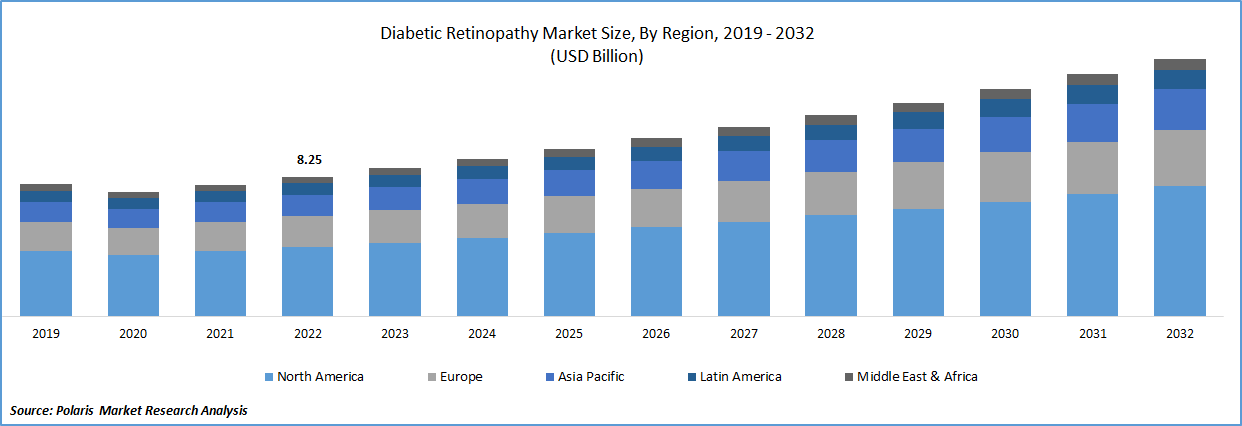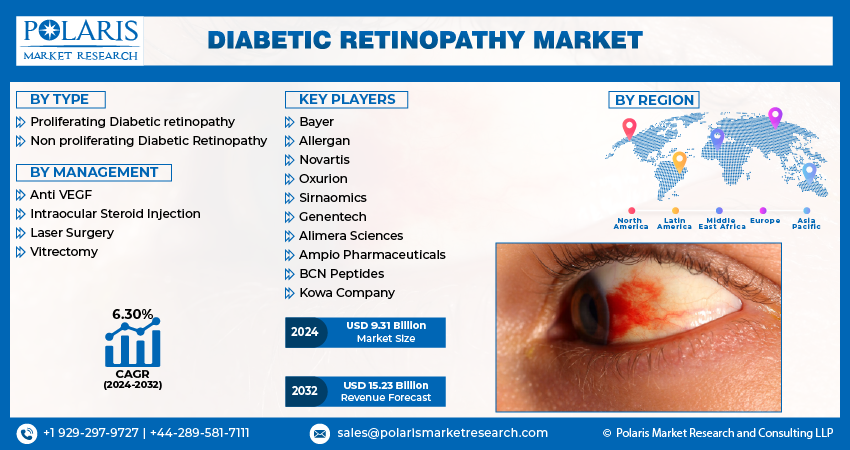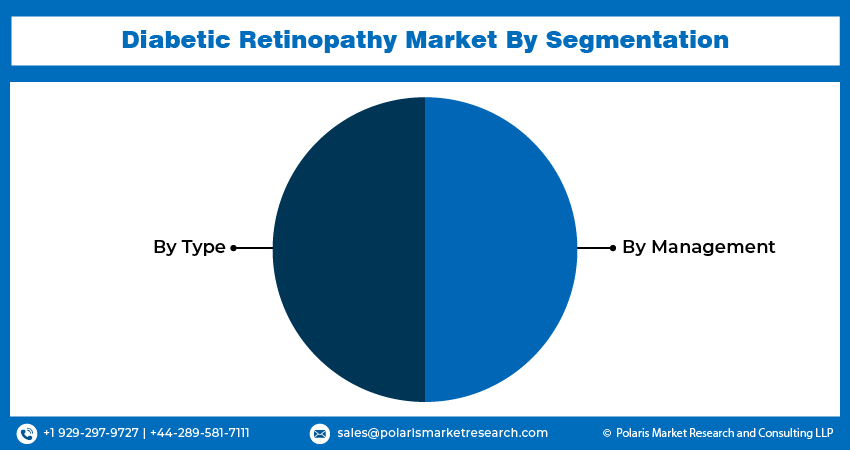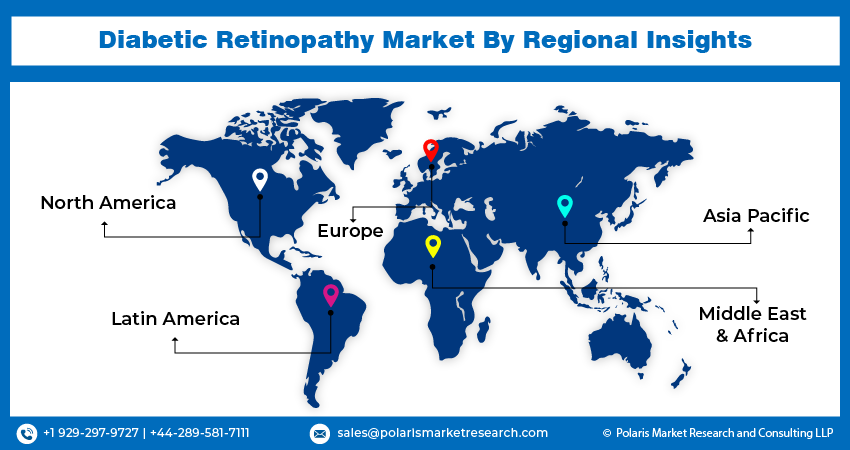
Diabetic Retinopathy Market Share, Size, Trends, Industry Analysis Report, By Type (Proliferative DR, Non-proliferative DR); By Management (Intraocular Steroid Injection, Laser Surgery, Vitrectomy); By Region, And Segment Forecasts, 2024 - 2032
- Published Date:Jan-2024
- Pages: 116
- Format: PDF
- Report ID: PM3621
- Base Year: 2023
- Historical Data: 2019-2022
Report Outlook
The global diabetic retinopathy market was valued at USD 8.76 billion in 2023 and is expected to grow at a CAGR of 6.30% during the forecast period. Rising prevalence of diabetes, the growing geriatric population, and the increasing incidence of blindness associated with diabetes. These factors create a strong demand for products and solutions aimed at diabetes management and care. Additionally, the market is influenced by the increasing awareness among individuals about the importance of diabetes management and the need for effective solutions. This growing awareness drives the adoption of products and services related to diabetes care. Furthermore, the introduction of new products into the market further stimulates its growth by providing innovative solutions for diabetes management and improving the quality of life for individuals with diabetes.

To Understand More About this Research: Request a Free Sample Report
Constant self-monitoring of blood glucose levels using advanced tools like glucose meters or continuous glucose monitoring systems can provide valuable information for patients to manage their diabetes effectively. Alongside proper medication adherence and lifestyle modifications, such as maintaining a healthy diet, regular exercise, and avoiding tobacco and excessive alcohol consumption, individuals can reduce the risk and severity of diabetic retinopathy.
Diabetic retinopathy is a progressive condition, and its severity can vary from mild to severe, depending on the individual and the stage of the disease. In the early stages of diabetic retinopathy, individuals may not experience any noticeable symptoms or vision problems. However, as the disease progresses, it can lead to various complications that can affect vision. These complications include the growth of abnormal blood vessels in the retina, leakage of blood or fluid into the retina, and the formation of scar tissue. These changes can impair the normal functioning of the retina, leading to vision loss.
The risk of vision loss due to diabetic retinopathy can be mitigated through early detection and timely intervention. Regular eye examinations, especially for individuals with diabetes, are essential for detecting any signs of retinal damage. If diabetic retinopathy is detected, appropriate treatments, such as laser therapy, injections, or surgery, may be recommended to prevent further vision loss. In January 2023, CheckEye, a healthtech firm based in Ukraine, introduced a mobile solution aimed at organizing diabetic retinopathy (DR) screening for diabetic patients and their families. The company is utilizing an AI-powered cloud-based platform to facilitate the early detection of DR. The Ukrainian Diabetes Federation and The Filatov Institute for Eye Diseases collaborated with and provided support to the screening initiative conducted by CheckEye.
According to the Royal National Institute of Blind People (RNIB), diabetic retinopathy ranked among the primary causes of blindness in the United Kingdom in 2018. Factors such as growing patient awareness and increased healthcare spending are expected to contribute to the expansion of the diabetic retinopathy market. Additionally, the World Health Organization (WHO) predicts a significant increase in the global elderly population by 2050 compared to 2020, underscoring the importance of maintaining a healthy lifestyle, managing obesity, and continuous monitoring of blood glucose levels in this vulnerable demographic.

Industry Dynamics
Growth Drivers
Diabetes is indeed a significant global health issue characterized by the pancreas's insufficient production of insulin, leading to elevated blood glucose levels. One of the complications associated with diabetes is diabetic retinopathy, a condition caused by damage to the blood vessels in the retina. As a result, individuals with diabetic retinopathy may experience symptoms such as blurred vision and, in severe cases, vision loss. It is crucial to manage diabetes effectively and undergo regular screenings to detect and treat diabetic retinopathy in its early stages to prevent further vision impairment and complications.
High blood sugar levels and inadequate monitoring of glucose levels are significant risk factors that can contribute to the development and progression of diabetic retinopathy. By effectively managing diabetes, including maintaining optimal blood sugar control, individuals can potentially reduce the risk of diabetic retinopathy and its complications. Early detection of diabetes is crucial in preventing or minimizing the impact of diabetic retinopathy. Regular screenings and comprehensive eye examinations can help detect any signs of retinal damage at an early stage. Timely treatment interventions, such as laser therapy or medications, can be initiated to slow down the progression of the condition and preserve vision.
Report Segmentation
The market is primarily segmented based on type, management, and region.
|
By Type |
By Management |
By Region |
|
|
|
To Understand the Scope of this Report: Speak to Analyst
Anti-VEGF Segment Accounted for the Largest Market Share in 2022
Segment’s growth is attributed to the use of anti-VEGF drugs in the treatment of diabetic retinopathy. These drugs have demonstrated high effectiveness and efficiency in addressing the condition. They are particularly popular for treating Proliferative Diabetic Retinopathy (PDR). These agents have been found in beneficial in cases of PDR accompanied by vitreous hemorrhage, neovascular glaucoma, and prior to vitrectomy procedures.
In contrast, intraocular steroidal injection is a newer treatment option for diabetic retinopathy and Diabetic Macular Edema (DME) compared to anti-VEGF agents, but it is gradually gaining traction. These injections involve the use of corticosteroid-based drugs, which help in controlling cellular proliferation. Among the various corticosteroids being studied, Triamcinolone (Durezol) has demonstrated the most favorable therapeutic performance and has established a strong presence in the market.
Non-proliferative Diabetic Retinopathy Segment Expected to Hold Significant Market Share
Non-proliferative diabetic retinopathy segment is projected to hold significant market share in terms of revenue over the study period. This can be attributed to factors such as the growing geriatric population and the increasing incidence of blindness caused by diabetes. These factors have contributed to the significant share of non-proliferative diabetic retinopathy in the market. Additionally, there is a rising demand for regular retinal screening among patients with long-standing diabetes, which is expected to further drive the growth of this segment.
Proliferative Diabetic Retinopathy (PDR) segment recoded robust growth rate. It represents an advanced stage of the retinopathy characterized by the abnormal growth of fragile vessels in the retina and vitreous humor, leading to symptoms such as blurred vision & potential blindness. In some cases, PDR may also result in macular edema, which may not exhibit symptoms during early stages. Diagnosis of PDR typically involves comprehensive eye exams, including tonometry and visual acuity tests, among others.

North America region dominated the global market in 2022
The North America region dominated the global market with considerable market share in 2022. Region’s growth is particularly due to presence of anti-VEGF drugs such as Lucentis, Avastin, and Eylea. These medications have proven to be highly effective in managing diabetic retinopathy, Factors such as high healthcare expenditure, increasing patient awareness about diabetes and its complications, the presence of well-established healthcare infrastructure, and a favorable reimbursement framework further drive the growth.
The Asia Pacific region is anticipated to be the fastest growing region throughout the projected period. This growth can be attributed to several factors. Firstly, the region has high unmet medical needs, indicating a substantial patient population that requires effective diagnostic procedures and treatments for diabetic retinopathy. Secondly, there is a rapid increase in patient awareness about the condition, leading to early detection and intervention. Additionally, the emerging economies of India and China are witnessing rising healthcare expenditures, which contribute to improved access to healthcare services for diabetic patients.

Competitive Insight
Investments in R&D enable market leaders to innovate and develop new drugs or treatment options, which can address unmet medical needs, improve patient outcomes, and potentially gain a competitive edge. These investments involve extensive scientific research, clinical trials, and regulatory processes to ensure the safety and efficacy of new products. By focusing on R&D, market leaders demonstrate their commitment to advancing medical science and bringing innovative solutions to the market. These efforts often result in the development of breakthrough therapies, improved treatment options, and enhanced patient care.
Some of the major players operating in the global market include Bayer, Allergan, Novartis, Oxurion, Sirnaomics, Genentech, Alimera Sciences, Ampio Pharmaceuticals, BCN Peptides, and Kowa Company.
Recent Developments
- In January 2023, Eyenuk, a renowned global digital health company specializing in artificial intelligence (AI) technology, has obtained approval to market its EyeArt AI eye screening system in the European Union. This approval allows Eyenuk to expand the application of its AI technology beyond its existing uses and include the detection of age-related macular degeneration (AMD) and glaucomatous optic nerve damage, which is an indicator of glaucoma.
Diabetic Retinopathy Market Report Scope
|
Report Attributes |
Details |
|
Market size value in 2024 |
USD 9.31 billion |
|
Revenue forecast in 2032 |
USD 15.23 billion |
|
CAGR |
6.30% from 2024 – 2032 |
|
Base year |
2023 |
|
Historical data |
2019– 2022 |
|
Forecast period |
2024 – 2032 |
|
Quantitative units |
Revenue in USD billion and CAGR from 2024 to 2032 |
|
Segments covered |
By Type, By Management, By Region |
|
Regional scope |
North America, Europe, Asia Pacific, Latin America, Middle East, & Africa |
|
Key companies |
Bayer, Allergan, Novartis, Oxurion, Sirnaomics, Genentech, Alimera Sciences, Ampio Pharmaceuticals, BCN Peptides, and Kowa Company |
FAQ's
The global diabetic retinopathy market size is expected to reach USD 15.23 billion by 2032.
Key players in the diabetic retinopathy market are Bayer, Allergan, Novartis, Oxurion, Sirnaomics, Genentech, Alimera Sciences, Ampio Pharmaceuticals
North America contribute notably towards the global diabetic retinopathy market are type, management, and region.
The global diabetic retinopathy market is expected to grow at a CAGR of 6.3% during the forecast period.
The diabetic retinopathy market report covering key segments are type, management, and region.
